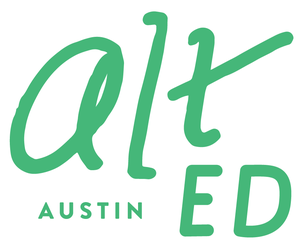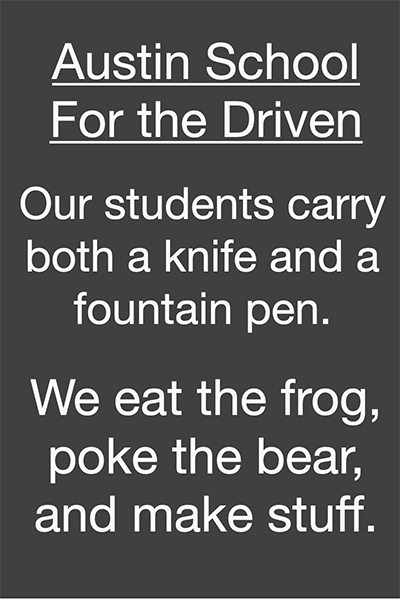Architecting a better school
/We’re pleased to share this guest contribution from Tim Derrington, AIA + LEED AP. Tim is founder of Derrington Building Studio, a full-service architecture practice in Austin that focuses on relationship-based design, working closely with clients to deliver practical buildings that don’t sacrifice great design.
Parents considering enrolling their kids in an alternative school tend to look into things like teaching philosophy, location, cost, classroom quality, educational achievements, and specialty programs when evaluating which one is best for their children. While all of those things matter a great deal, what if I told you that the built environment is among the most critical components to your child’s education and well-being?
The success or failure of children’s learning environment influences everything from how engaged they are in the classroom to their level of focus when learning new skills to even their performance. Environment sets the tone for our learning and future growth.
It is surprising, then, to find that most schools in the United States are made up of outdated facilities and failing infrastructure that do not meet modern-day health, safety, and educational standards. Not to mention the often uninspired facilities and dismal portable classrooms that many of our funding-deprived, overcrowded schools find themselves made of today.
So how can we change the state of our schools from designs that are outdated to designs that adapt to meet the needs of modern-day education?
The Case for a New Kind of School Architecture
I am an architect, and a few years ago I had the opportunity to design an addition to the Khabele Elementary School campus. It was my first time designing a school and an exciting project for me as an up-and-coming architect in Austin.
Immediately upon getting the project, I started researching precedents, pedagogies, building technology, and many other factors that might influence the seemingly infinite possibilities when it comes to designing a school. I explored the work and teachings of some of our greatest educational thinkers, both old and new—people like Maria Montessori, Friedrich Wilhelm Froebel, and Sir Ken Robinson. I studied buildings that seemed to push the envelope on what a school could be. There were so many ideas and perspectives on what makes a great environment for learning, yet so many failed school designs in existence.
Ultimately, I asked myself how architecture could affect a child’s learning potential and behavior. These were the factors I found to be most important and what I personally recommend every parent and educator consider when evaluating schools.
Flexible, Learner-Friendly Spaces
There are few things I can think of that are more limiting to a young mind than predictable, unstimulating environments. There are so many buildings that succumb to the constraints of budgets and building codes and forego the opportunity to imagine wonderful spaces—in particular, spaces that encourage kids to explore, dream, observe and reflect. This happens more often than not and is a condition my team and I strive to change in our day-to-day practice as architects.
What I have learned is that the most successful environments, especially those that focus on learning, offer flexibility and support a diverse set of activities and needs. Schools that have classrooms that can provide for everything from larger group discussions to small-group learning opportunities or individual creative exercises tend to win out and offer the best functionality.
Why?
A more flexible space doesn’t limit the child to one environment. This may seem obvious, but many of our schools today fail to provide flexible learning environments for their students. Students need options and the ability to choose what space they learn best in, which in turn helps increase their level of engagement and learning potential.
Want to provide a focused lesson to a group of 10 students? Need to perform individualized creative projects? Those scenarios call for very different spaces but are nearly always done in the same classroom.
When all of the parts and pieces of a classroom can be easily adjusted to meet the needs of the day, the space comes to life with unique characteristics that make up a better-functioning and diverse space to learn, wonder, and create.
Learning That Spans Both Indoors and Outdoors
Among other things, architecture is about striking a balance between providing shelter from the elements and encouraging connection to your environment. This balance has been found to be especially powerful as a learning tool, bringing people closer to nature as an educational space.
In the case of the Khabele school, a visible relationship to nature was especially important. All of the rooms have large windows that offer plenty of natural light and views of trees and the surrounding forest.
Lighting is the most important environmental input after food and water for controlling bodily functions and behavior. For this reason, optimizing natural lighting was a key aspect of the Khabele school design and should be a top priority in any new school development.
In our research, we found that full-spectrum natural lighting not only helps reduce energy consumption but also determines the body’s output of vitamin D, a critical component to a child’s health and development. It has even been found to raise students’ grade point averages and make children less “hyper.”
Beyond just the lighting, we found that windows overlooking the outdoors were crucial.
Outdoor learning environments are becoming more and more popular as a means of involving students in the study of ecology and greener environments. Integrating school structures with natural quiet areas as well as play areas is also very important. We wanted to encourage that connection by providing lines of sight to the trees and play areas outside the classrooms.
My team and I made a conscious decision to showcase beautiful natural material, including stone and wood, to mimic the existing building on campus while also blending in with the surrounding Texas hill country. The importance of infusing a child’s physical setting with a direct, physical connection to nature cannot be overstated.
Fostering Environments That Are Welcoming
The main entrance is the first thing every child sees when arriving at school. This entrance has the opportunity to be welcoming and approachable, or unfriendly and withdrawn.
I’d bet you that any parent and their child would want their school to look welcoming, for obvious reasons. A school should be a friendly place that encourages learning. Welcoming entrances also serve the role of orienting children as they move throughout the school’s campus, serving as a visible pillar of the school and giving it a sense of community.
Although Khabele already had a building on this campus, we considered how our addition to the school could serve to better welcome and orient students.
A wooden deck served as the main pathway to the new classrooms, signaling to students and teachers alike that they should enter the space.
The deck was made extra wide so that it could easily accommodate clusters of students moving back-and-forth from class while also being a visible point of reference for students and visitors.
Looking Forward: The Future of School Design
Designing the next generation of schools requires having an open-table discussion among students, educators, parents, and architects. With limited research in this area, it is up to us to determine what elements of a school design work best and what needs to be refined in order to create schools that support the growth and development of future generations. Through these collaborations, we can stop letting poorly designed schools limit great teaching moments and take their toll on student learning.
Most importantly, we can ensure that our schools’ philosophies are better reflected and supported by the environments in which they are taught while also encouraging a greater appreciation for the built environment.
Tim Derrington





























